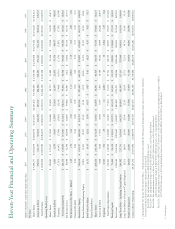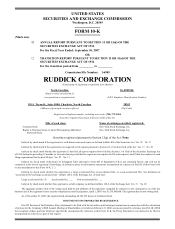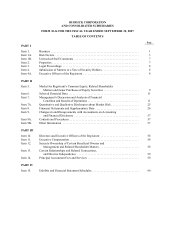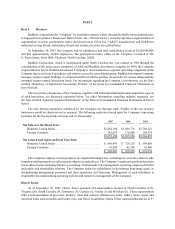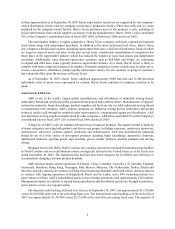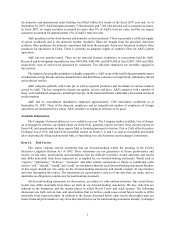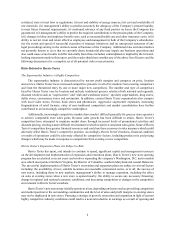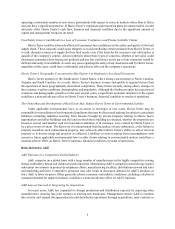Harris Teeter 2007 Annual Report Download - page 8
Download and view the complete annual report
Please find page 8 of the 2007 Harris Teeter annual report below. You can navigate through the pages in the report by either clicking on the pages listed below, or by using the keyword search tool below to find specific information within the annual report.4
in federal, state or local laws or regulations; (ii) cost and stability of energy sources; (iii) cost and availability of
raw materials; (iv) management’s ability to predict accurately the adequacy of the Company’s present liquidity
to meet future financial requirements; (v) continued solvency of any third parities on leases the Company has
guaranteed; (vi) management’s ability to predict the required contributions to the pension plans of the Company;
(vii) changes in labor and employee benefit costs, such as increased health care and other insurance costs; (viii)
ability to recruit, train and retain effective employees and management in both of the Company’s subsidiaries;
(ix) the extent and speed of successful execution of strategic initiatives; and (x) unexpected outcomes of any
legal proceedings arising in the normal course of business of the Company. Additional risks and uncertainties
not presently known to us or that we currently deem immaterial also may impair our business operations and
also could cause actual results to differ materially from those included, contemplated or implied by the forward-
looking statements made in this report, and the reader should not consider any of the above list of factors and the
following discussion to be a complete set of all potential risks or uncertainties.
Risks Related to Harris Teeter
The Supermarket Industry is Highly Competitive
The supermarket industry is characterized by narrow profit margins and competes on price, location
and service. Harris Teeter faces increased competitive pressure in all of its markets from existing competitors
and from the threatened entry by one or more major new competitors. The number and type of competitors
faced by Harris Teeter vary by location and include: traditional grocery retailers (both national and regional),
discount retailers such as “supercenters” and “club and warehouse stores,” specialty supermarkets, drug stores,
dollar stores, convenience stores and restaurants. In addition, certain Harris Teeter supermarkets also compete
with local video stores, florists, book stores and pharmacies. Aggressive supercenter expansion, increasing
fragmentation of retail formats, entry of non-traditional competitors and market consolidation have further
contributed to an increasingly competitive marketplace.
Additionally, increasingly competitive markets have made it difficult generally for grocery store operators
to achieve comparable store sales gains. Because sales growth has been difficult to attain, Harris Teeter’s
competitors have attempted to maintain market share through increased levels of promotional activities and
discount pricing, creating a more difficult environment in which to achieve consistent sales gains. Some of Harris
Teeter’s competitors have greater financial resources and could use these resources to take measures which could
adversely affect Harris Teeter’s competitive position. Accordingly, Harris Teeter’s business, financial condition
or results of operations could be adversely affected by competitive factors, including product mix and pricing
changes which may be made in response to competition from existing or new competitors.
Harris Teeter’s Expansion Plans Are Subject to Risk
Harris Teeter has spent, and intends to continue to spend, significant capital and management resources
on the development and implementation of expansion and renovation plans. Harris Teeter’s new store opening
program has accelerated in recent years and involves expanding the company’s Washington, D.C. metro market
area which incorporates Northern Virginia, the District of Columbia, southern Maryland and coastal Delaware.
The successful implementation of Harris Teeter’s renovation and expansion plans are subject to several factors
including: the availability of new, suitable locations on reasonable commercial terms, or at all; the success of
new stores, including those in new markets; management’s ability to manage expansion, including the effect
on sales at existing stores when a new store is opened nearby; the ability to secure any necessary financing;
change in regional and national economic conditions; and increasing competition or changes in the competitive
environment in Harris Teeter’s markets.
Harris Teeter’s new stores may initially operate at a loss, depending on factors such as prevailing competition
and market position in the surrounding communities and the level of sales and profit margins in existing stores
may not be duplicated in new stores. Pursuing a strategy of growth, renovation and expansion in light of current
highly competitive industry conditions could lead to a near-term decline in earnings as a result of opening and


